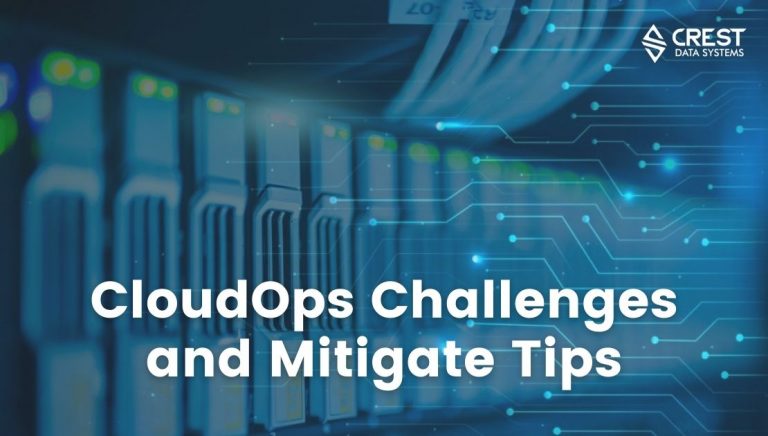CloudOps Challenges & Mitigation Tips

Cloud Operations (CloudOps) refers to the management activities of cloud-native applications and the underlying processes that keeps the infrastructure up and running. Combinations of network, delivery and consumption, security, performance that create best practices to ensure high availability and an optimized performance.
The principles of DevOps are extended and are meant to be complemented in CloudOps to optimize IT services and procedures to achieve reliable access to a given cloud environment. Cloud computing can offer many benefits when compared to traditional on-prem architecture.
CloudOps can help organizations to gain the full potential of the public cloud offering better availability, performance, and control at scale. The following are some of the common advantages of cloud operations:
- Reduction in Total Cost of Ownership (TCO)
- Automation
- Scalability & Agility
- High Availability (HA)
- Faster time to market & shorten development cycles
- Opportunities for innovation to meet market demands
- Improved performance
- Flexibility of resource demands
- Security and Compliance
- Data recovery and backup
But with these advantages comes challenges as well, understanding common issues will help your team prepare before implementing CloudOps practices.
Challenges with CloudOps
With the rise of the cloud, teams are anxious to migrate and reap the benefits to eliminate downtime and make continuous operations and improved performance a reality. But as organizations approach CloudOps as a solution, what should teams be prepared for?
Complexity – Organizations in an attempt to quickly adopt CloudOps may subscribe to multiple cloud tools in ad hoc fashion compiling multiple services while not giving enough consideration to the complexity this introduces and the skill professionals required to maintain the solutions.
A report, Bridging the Cloud Transformation Gap states 72% of organizations view the cloud as a driver of increased efficiency but just 33% reported complete success at it. And goes on to say that organizations need to identify the gaps between expectations and reality to maximize the value of your cloud transformation.
CloudOps Skill Gap – ITPro states, 90% of organizations have reported a lack of skills in multiple cloud disciplines and that the deficit has doubled over the last three years. The lack of public cloud platform expertise is also driving organizations towards managed service providers.
The digital transformation that comes with cloud computing has pushed companies to invest more on the expertise required to manage these systems, creating more specialized jobs and careers. This is an effort to address the widening gap where certain cloud roles are not being filled simply because not enough people have the skills for it, as reported by a 451 research, Demystifying cloud transformation: Where enterprises should start.
Legacy Application & Modernization – Legacy applications could be holding your business back. Gartner states, Digital transformation has made it imperative for application leaders to find effective ways to modernize legacy systems. The biggest challenge? Knowing the risk-to-reward ratio before acting.
“For many organizations, legacy systems are seen as holding back the business initiatives and business processes that rely on them,” Stefan Van Der Zijden, VP Analyst, Gartner. “When a tipping point is reached, application leaders must look to application modernization to help remove the obstacles.”
When a company is ready to migrate to the cloud, evaluate the business and IT drivers. Determine if using “everything”-as-a-service may be aligned with your business goals and growth and reduce overall operation costs and total cost of ownership (TCO).
Budget & Key Stakeholder Support – Upfront budget may be a challenge to justify to decision makers and stakeholder for adoption. Budget simply may not be available or allocated in an organization. But the argument should be made that the operational and TCO savings and advantages again will surely make this a wise business decision staged for growth.
Security & Threats – While some cloud vendors can offer end to end security solutions for your cloud environment, customers should be aware that all processes and systems can have vulnerabilities. Cloud computing introduces a new attack surface and in many cases, multiple attack surfaces for cybercriminals to exploit and compromise sensitive systems in a potential data breach.
Statista states, in 2020, the cloud security software market was valued at 29.5 billion U.S. dollars and is expected to exceed 37 billion U.S. dollars in 2026.
2021 saw the highest average cost of a data breach in 17 years, with the cost rising from US$3.86 million to US$4.24 million on an annual basis. (IBM Cost of a Data Breach Report 2021).
Though this same report also states that, organizations further along in their cloud modernization strategy contained the breach on average 77 days faster than those in the early stage of their modernization journey.
Vendor Lock In – Operating in the cloud means our workloads can be anywhere we require. This demand is often met with vendors that can offer hyperscale solutions to meet most of your growing business requirements. Consolidating resources to a single vendor can help to simplify your cloud environment but if you ever need to move your data and cloud operations to another service provider, you may find the process complicated and too dependent on its services leaving you to what is known as vendor lock in.
To address this, more businesses are moving towards and adopting a multi-cloud strategy. Gartner states that, “Most organizations adopt a multicloud strategy out of a desire to avoid vendor lock-in or to take advantage of best-of-breed solutions” – Michael Warrilow, VP Analyst, Gartner.
While it can be difficult to avoid some form of dependency, do not forget that an advantage of cloud computing is allowing you the flexibility to implement and maintain multi-cloud and hybrid-cloud architectures and solutions to meet your business and IT success.
Mitigation Tips & Solutions for the Future
The good news is organizations can take steps to mitigate these challenges to actualize the benefits of CloudOps. Take time to properly plan and prepare by developing a cloud migration strategy that addresses and can plan a response to the challenges discussed. Collaborate with teams to visualize the entire architecture to have a holistic view of how processes and solutions will work together and any interoperability issues that may surface. This is valuable to know and uncover at this preliminary stage.
It may make sense to start with a Proof of Concept (POC) to show key stakeholders the business, operational, and technical benefits to help your decision for adoption.
Plan to implement automation and AI enabled tools to address the complexity that cloud and multi-cloud environments can bring. Adopt agile cloud workflows to continuously improve processes that give more time to your teams to focus on reaching business goals and not maintaining and responding to the large amounts of data collected in the cloud.
To further enhance and harden your security posture, AI coupled with machine learning and predictive analytics provide organizations with the tools and a comprehensive view to protect their cloud infrastructure from potential threats before they occur and can detect and respond to vulnerabilities or suspicious and anomalous activity before compromise.
Along with adopting cloud-native applications, using microservices techniques and containers to isolate processes during development for your IT teams will give you the flexibility and opportunities for innovation to build and meet market demands without affecting other applications while in the cloud.
Assembling an integrative and holistic suite of cloud apps will allow you to hyperscale and help your organization reap the benefits of CloudOps while minimizing headaches along the way.
How Crest Data Systems Can Help
With Crest Data Systems CloudOps Solutions & Services, our engineers work with your team and become an integral part of the transformational journey to evaluate enterprise infrastructure, platforms, and applications. We help companies perform Reliability Assessments, ensure Reliable System Architecture Design and recommend Optimization of end to end Day 2 operations tasks as per SRE best practices.
Crest Data Systems has worked with Fortune 500 companies as well as some of the world’s most innovative companies and hottest startups to streamline work processes so teams can perform at their highest level.
Contact us to learn more about our Product Engineering solutions and our broad range of managed and professional services that encompass solution implementation, building integrations,enable migration, health checks, and see how we can help you today.

AUTHOR –
TUAN NGUYEN
Tuan is a Product Marketing Manager with 8+ years of industry experience in large Enterprise technology companies and start-up. He is passionate about technology marketing and has experience in Cybersecurity, Cloud Security, and Data Center Networking.

